I continue to have unpleasant encounters with low flying planes.
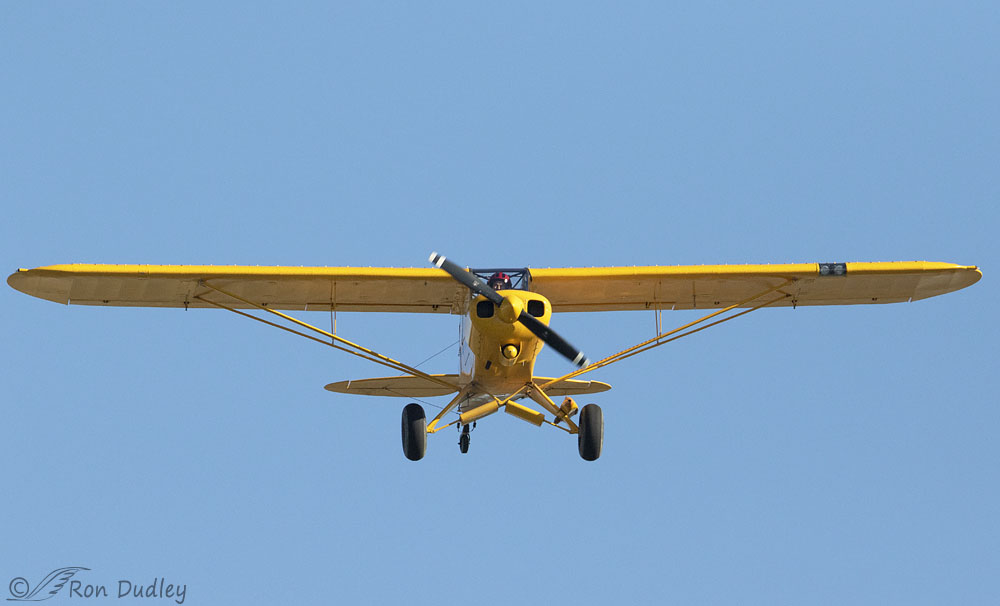
Recently I posted this photo of an aircraft flying extremely low over Antelope Island State Park ten days ago on April 19th.
At this angle none of my photos showed the plane’s N-number so I couldn’t look up ownership registration on the FAA website but blog follower “Michael” said this in a comment:
- “I believe a shot I took from the causeway a few weeks back is the same plane here. I also thought it was flying unusually low. The N-number of the one I shot is N367CC. If it’s the same plane it looks to be conducting official business by who the RO (registered owner) is.”
At the time I presumed that the two planes were one and the same and that N-number is registered to a US government agency (USDA-APHIS-WS) so I figured they were on official business and had good reason to be flying so low over the state park, noisy and annoying as it was.
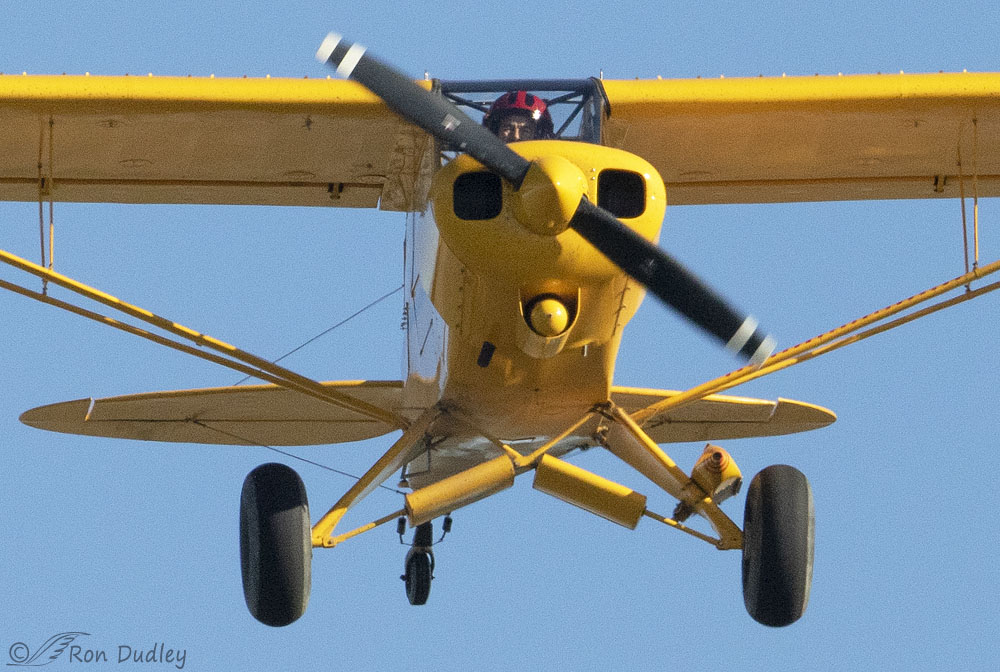
Here’s a closeup of the first photo. I decided to include it for better detail in identifying the plane.
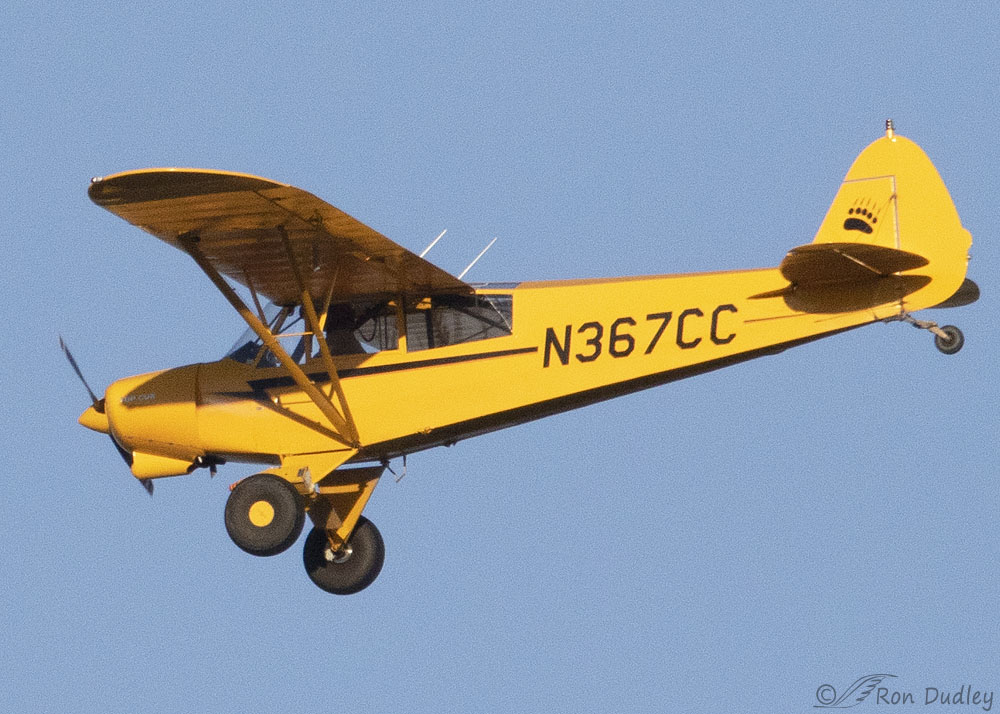
Then, six days later on April 25 I photographed this plane flying low over the island. Notice that it has the same N-number as the aircraft that Michael photographed flying “unusually low” over the causeway so there’s no question that they’re one and the same aircraft. And at first glance it looks very much like the one I photographed originally (1st photo).
However, despite the very close similarities they’re apparently not the same plane. If you compare the wingtips of this one to the plane in the first photo you’ll notice that they’re painted different colors. If you look carefully there are other more subtle differences too.
So even if I give the benefit of the doubt to N367CC and assume it’s a government plane on official and “righteous” business I have to wonder what the first aircraft was doing flying so low over a state park. And I also have to wonder about the coincidence of two nearly identical planes flying low over the island in less than a week. It was truly annoying and I’m sure the wildlife and birds didn’t appreciate it either.
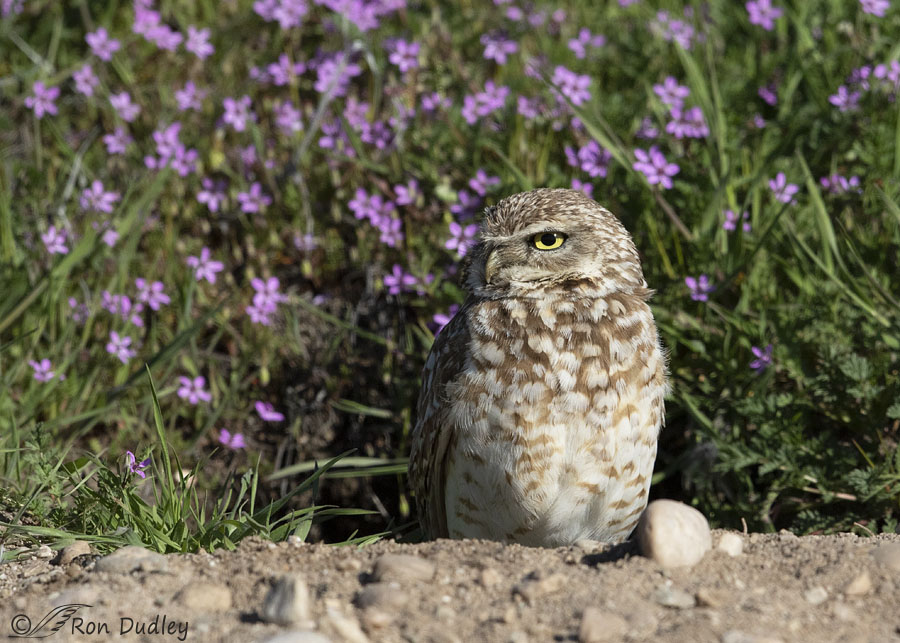
I know for fact that the Burrowing Owl I was photographing at the time wasn’t pleased and some rogue pilots get their kicks by deliberately harassing wildlife, particularly larger mammals like bison and pronghorn.
At this point you may be thinking I’m a little obsessed by low-flying planes, making a bigger deal out of them than I should. But in the ten years I’ve been photographing birds I’ve had many unpleasant encounters with them, especially in wild or remote areas where pilots think they can get away with such hijinks since they don’t know I have a high quality telephoto lens that can clearly document their nefarious activities.
Following is the most recent example. Two days ago as I was attempting to photograph birds in another remote area of northern Utah I suddenly heard the sound of a plane approaching fast and extremely low, I’d say dangerously so. I’d been shooting out my window but when I looked forward through my windshield I could see the plane coming directly at me as it skimmed very low over the shoreline flatlands of the Great Salt Lake. Within seconds that plane almost took up my entire windshield and I’m not exaggerating!
I dearly wish I’d had the presence of mind to snap a cell phone photo through my windshield but I didn’t because I was simply stunned by what I was seeing. That would have been a helluva dramatic photo! It was extremely obvious that the pilot had seen my pickup from a distance and was deliberately buzzing me.
The plane passed almost directly over me with a roar and disappeared to the south.
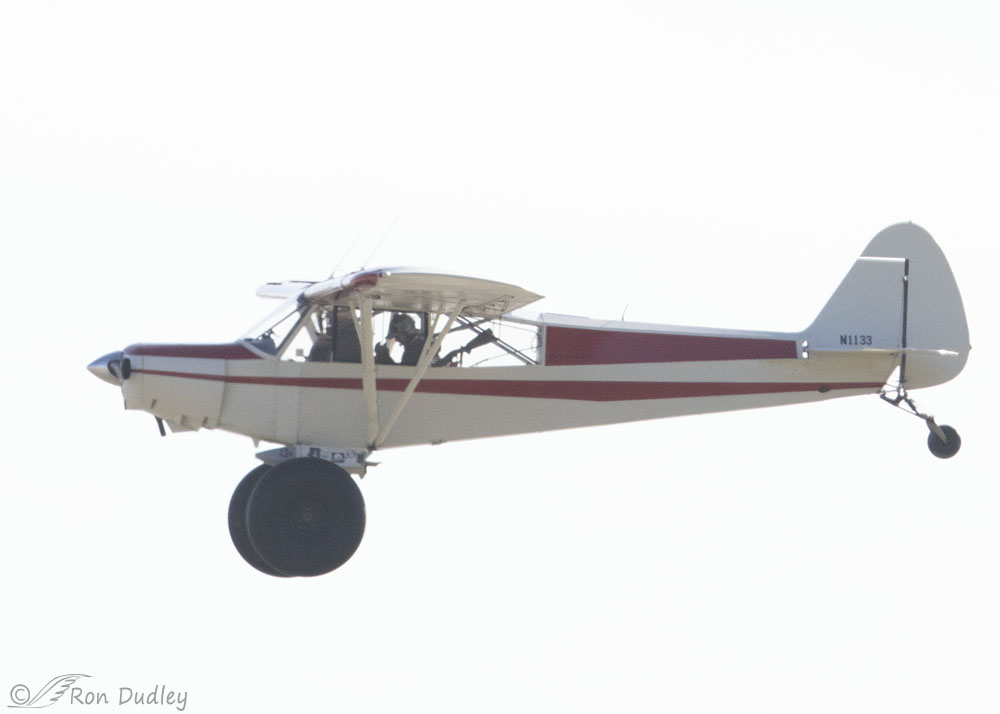
But several minutes later it returned, flying north about a quarter-mile away from me and not quite so low this time. At this angle it was badly backlit but I hopped out of my pickup and took some photos anyway because I was pissed off – birds I’d been trying to photograph took cover at the roar of the plane and it would be some time before they would come out again.
It was a Piper PA-18-135 Super Cub with a pilot and a passenger sitting behind him. I’m almost certain they were hunting coyotes, a practice I abhor. Notice the object that appears to be a rifle directly behind and within easy reach of the passenger.
I have a couple of questions for any of my readers who may be more aircraft-knowledgeable than I am:
- Am I correct in assuming that the fat and hugely oversized tires are designed for landing on soft and/or rough surfaces? In this case they’re probably meant to allow the pilot to land on the sandy, mucky flats surrounding the Great Salt Lake so they can collect their coyote carcasses and their blood money from the state (Utah pays a $50 bounty to anyone who turns in coyote body parts).
- Compare the size of the N-numbers of this aircraft to the plane in the third photo. It seems to me that N-numbers the size of those on this plane are next to useless because they’re so small and I have to wonder if they even conform to FAA regulations. Any thoughts?
I checked the FAA Registry and this last aircraft is registered in the same county I was in when I took the photo.
The FAA has a rule called the “500 foot rule” that goes something like this:
- “An aircraft must maintain an altitude of 500 feet above the surface, except over open water or sparsely populated areas. In those cases, the aircraft may not be operated closer than 500 feet to any person, vessel, vehicle, or structure.”
I was in a “sparsely populated area” to be sure but when this plane buzzed me I strongly believe it came significantly closer to me than 500′ but I can’t prove it with photos so I won’t be reporting the incident to the FAA (I know from experience that they won’t investigate without such proof).
Personally I’m sick to death of these hotdog pilots who think they can do just about anything in remote areas just because they can get away with it. Given my track record with them it won’t be long until it happens again and next time I’ll be quicker with my cameras.
Then the FAA can decide if they want to pursue the incident.
Ron
PS – I can hear it already. If the pilot of this last plane ever gets wind of this post (he just might and that’s fine by me) he may claim that he was checking me out to make sure I was ok and not broken down. I won’t buy that, not ever. He came way too close for that, much closer than he needed too unless he was blind. Don’t think there are many blind pilots out there. He was just hot-doggin’ me.
Besides he was coming head on to me which as he got closer would put me in the pilot’s blind spot in front of and below him. Both pilot and passenger would have been able to see me much better at a more oblique approach angle.


Very annoying and frustrating Ron!
Charlotte
I don’t blame you for being annoyed. We have bounty hunters here as well. Bragging how many “they bagged”. Poor Coyotes. Protecting yourself is one thing, killing for the thrill is another. Beautiful photo of the Owl.
Thank you, Jean. I was more than annoyed by the pilot who buzzed me.
Hiss and spit. Which is all I can add to the commentary. Sorry.
Hiss and spit works for me, EC.
Love the way you think, EC!!!
Reading this post and its comments has been an eye opener. I have been photographing wildlife on Antelope Island for years with great success, always leaving with a positive vibe and wonderful experiences. This began to change over the last year or so. I am not a big fan of Utah politics and learning more about predator practices in the state makes my stomach turn. It is no wonder I’ve seen less and less coyotes on my travels. Who do these individuals think they are and why haven’t attitudes toward wildlife changed for the better? I fear the peace and serenity I always found on Antelope Island is becoming a thing of the past. And I just purchased another Utah state parks pass yesterday. What was I thinking?
Sandy, don’t jump to conclusions just yet.
But I’ll definitely be asking some questions. And soon!
Thanks Ron! I forgot to say how much I love your posts, photography and dedication.
Much appreciated, Sandy. And look for an update on all of this tomorrow. I went poking my nose around this afternoon and found out some new stuff…
Is this second plane, the red and white one, from Sunday? If so would it have had anything with the cattle round up?
No, I photographed that plane on Saturday morning. Don’t know for sure if it had anything to do with any cattle drive but I can’t imagine why they’d need a plane or rifle for that.
Did you see the one Sunday along the foot hill and shore line?
I wasn’t out there on Sunday. Only Saturday morning.
There’s a picture on their web site of a different but very similar plane, and a description of their aerial operations at https://www.aphis.usda.gov/aphis/ourfocus/wildlifedamage/programs/CT_ATOC.
That’s an extremely interesting and potentially disturbing link, Mike – especially this part of it:
“In the Western Region, aerial missions are flown almost exclusively to protect valuable livestock (sheep, cattle, and goats) from predators. These missions use single-engine Super Cub or Top Cub aircraft flown at low altitude, and at relatively slow speeds”
That statement gives me pause, big time. We used to see coyotes on the island almost every visit – sometimes up to a dozen of them or so but in the last few years it’s unusual, almost rare, to see a coyote.
I’ve asked park rangers more than once if they’re practicing coyote control in order to “protect” the large mammals on the island. They’ve always denied it but this statement makes me seriously wonder if I’m getting the straight scoop from them.
I’ll be asking them more pointed questions in the near future, you can count on it.
A search for APHIS pops up the US Department of Agriculture – Animal and Plant Health Inspection Service. So maybe they did have legitimate business there. The gadget on the left strut could be some kind of air sampling thing. Seems like they would still have to follow the general low flying rules.
As I mentioned I suspect N367CC did have “legitimate business there”, Mike. But government pilots have human weaknesses too and I just don’t understand why they have to fly so low so often, especially over areas of the state park than can be easily accessed on foot or on horseback.
Besides the annoying and noisy disruption these low flying planes force on visitors to the state park they also disturb the wildlife so common on the island.
That said, I’m much more displeased by the pilot who buzzed me than I am with the aircraft flying low over Antelope Island.
It comes down to ethics and morality in my mind. In the past, I’ve seen a plane flying low looking for fox and then radioing it to people on the ground. This is immoral in my opinion. This is the same type of person who uses a snowmobile to chase down deer or uses a motor boat and raises a wake in a no-wake zone…just for the fun of it. Sometimes they get caught but many times not. I can’t understand the lack of consideration or lack of ethics some people seem to live by. But then we see a lack of respect in so much these days…
It’s sad, isn’t it Kathy. In fact it’s worse than just sad.
As a retired teacher I always think about the children folks like this are raising, who as adults will likely have the same values as their parents.
Go to hotline.faa.gov. That’s an address for an online form for air traffic control complaints. My husband was a GA pilot for decades and we had our own plane. We were always very careful with military space and any park or otherwise protected space. Please, let me know if we can be of help.
Barbara, I’m all too familiar with that link. See my response to Martha Ture below about reporting to the FAA.
Ron, we stand behind you in this campaign. Keep your excellent and vigilant work!
Thank you for the encouragement and support, Thomas.
While I was leading a wetlands walk about two months ago a motorized parachute flew very low over the wetlands. While the participants enjoyed seeing the Tricolored Heron which it flushed, it probably contributed to an otherwise dull morning for birding. This craft was not more than 10 feet above the surface at one point. In my neighborhood wetlands I have had as many as three of these contraptions fly low together, scaring the deer and herons. They even fly down between the trees. I must try to find the regulations/restrictions concerning their flights. They do not had identifying numbers that I can see.
Ken we have similar problems with those “motorized parachutes”, especially near the east end of the causeway to Antelope Island. I despise the damned things.
From the first photo, I can see that the underside of the wing tips are on a different plane (angle) than the rest of the wing. So I think the “different color” wing tip you’re seeing in the third photo is just a difference in light reflection caused by the different angle. I think they’re both the same airplane.
David, I considered that possibility but to me (what do I know) I thought the color difference was much too dramatic to be caused by light angles. After all, the rest of the underside of the wing is shaded too, yet the colors are so much different.
I’m not saying you’re wrong but at this point I’m not convinced they’re the same plane, even though it’s a huge coincidence that two planes so similar to each other would be flying low over the island.
I just don’t know and I’m the first to admit that I’m an ignoramus when it comes to aircraft. But as a photographer I do think (hope) I understand the effects of light fairly well…
I haven’t found any differences between the two. I don’t know what the device is that’s mounted to the left front landing gear. It has a forward facing cone with a hole in the center of it. I think it’s too big to be an air speed indicator. Anyway, that two planes would both be equipped with that, mounted in the same exact location would seem an extraordinary coincidence. Unless of course they were both owned by the same government entity. “Sister” planes, if you will. Just my opinion.
And I appreciate your opinion, David. You may be right but I remain unconvinced. However I’m not absolutely convinced about my opinion on the matter either.
GRRR! I’m SO with you Ron on your just anger with these egoistical, hotdogers!!! I have to keep telling myself that there are all kinds of good people out there who wouldn’t think of pulling this crap!!!
Thanks, Jo Ann. Yes, there are good people and good pilots that these clowns give a bad name to.
Hi Ron, My husband and I are both pilots, and many BAD pilots out there do fly too low, and ignore the 500 foot rule. This rule exists for a reason, and that reason is exactly what you state – so no person or animal is bothered by the plane! I would send these pictures to the FAA with your concerns and description of the events, if you feel comfortable doing this. The big tires on the Super Cub are for landing on unimproved surfaces.
Good pilots are always in a battle with bad pilots ignoring the rules and guidelines, just like with bad drivers on a road. It gives all pilots of small planes a bad name. Sorry you have to deal with these idiots.
Carol
“Good pilots are always in a battle with bad pilots ignoring the rules and guidelines”
Carol, that sounds almost exactly like what occurs with ethical nature photographers vs the unethical ones. Some things are universal.
See my response to Martha below about reporting to the FAA.
I am sad to learn of this ongoing misery but not surprised. You live in a part of the country that tolerates and even fosters this sort of activity. What I would do if I wanted to stop this activity:
1. I would identify the organizations that can and would successfully pressure the regulatory agencies to halt and stop fostering this kind of harassment. I would present it as an interruption of your personal and professional rights AND as a violation of FAA rules AND as a violation of applicable fish and wildlife regulations.
2.I would contact the Audubon Society and get their take on it. I would ask THEM for a recommendation for a good attorney who has practice in any of these fields. I would follow up with those attorneys. It is often the case that differing “rights” collide with one another.
3. I would look for each regulatory agency with authority over this kind of thing – US Fish and Wildlife, state Fish and Game, FAA, any others – and I’d find a contact in each outfit to whom to ask questions. I’d also look for a friendly county or state legislator.
4. Lastly, I would find out everything relevant about Robert Stokes – is he a contractor for Utah Fish and Game? Does he have any violations on his license? It’s all public record…
Realize that this nasty stuff is going to increase. You can either fight it and beat it by joining with other people and organizations, get used to it, or leave town. Alas. Sorry. Ruin hath taught me.
Thanks, Martha.
Ruin has taught me also. Twice I’ve reported such incidents to the FAA, including photos. But my photos didn’t include both the plane and the ground so they wouldn’t investigate further without more telling photographic proof of how close they were to the ground or to me.
I won’t go on a crusade about this because it would be too stressful and take up too much of my time. But I won’t ignore it either…
‘Am I correct in assuming that the fat and hugely oversized tires are designed for landing on soft and/or rough surfaces? In this case they’re probably meant to allow the pilot to land on the sandy, mucky flats surrounding the Great Salt Lake so they can collect their coyote carcasses and their blood money from the state (Utah pays a $50 bounty to anyone who turns in coyote body parts).’
YES, these wheels are for what you have stated plus they provide for softer landings on rough ground and more clearance for the propeller. Being a tail-dragger type plane during takeoff the tail of the plane lifts first and when landing you land on the main wheels and the tail touches last. These planes can be a handful when the tail wheel is on the ground
‘Compare the size of the N-numbers of this aircraft to the plane in the first photo. It seems to me that N-numbers the size of those in this plane are next to useless and I have to wonder if they even conform to FAA regulations. Any thoughts?’
Details on ‘N’ numbers can be found here https://www.faa.gov/documentLibrary/media/Advisory_Circular/AC_45-2E.pdf so depending upon the registration type for the plane they need to be either 3 inches or 12 inches. WHile the FAA registry says ‘Airworthiness is STandard’ it could be registered as antique, given the age of the aircraft, so N numbers would need to be a minimum of 3 inches tall.
FAA rules and guidelines can be confusing and ‘interpretive’ as you illustrate with the 500 foot rule.
Thanks for that feedback, Ron.
I can’t imagine why the FAA would allow N-numbers that small. At that size they would be next to useless in many, perhaps most, situations.
Very interesting as well as disturbing post Ron. No pilot should be coming that close to you when you are out there. With your truck etc you are obviously easy to see. That is definitely a rifle in the N1133. Is there a second person in the plane – hard to tell? I don’t know anything about the rules regarding coyote shooting in Utah or anywhere else, but like you I am 100% opposed to the practice. If the state has a bounty and hunters want to participate they should be on foot on the ground not in the air. To me that is a dangerous and unfair practice. Maybe some of your followers will have more knowledge of such things and can give you sound advice on the subject. I grew up in Pennsylvania where deer hunting is more popular than baseball, and I understand the thinning out over populated areas and all that, but personally I do not like hunting any living creature. Everett Sanborn, Prescott AZ
Thanks, Everett. Yes there are two people in the plane, the pilot and a passenger sitting behind him.
On hikes or visits to the beach I regularly pick up trash that others have left. It’s discouraging and makes me angry to know there are innumerable careless jerks who do this. But then I find I feel better about myself for picking it up and the anger dissipates. Your photography enriches us all, so you are clearly acting more honorably than the yahoos in the air. OK, that’s my sermon for today.
Thanks, Lyle. Yes, there are “yahoos” that will break every rule and exploit the situation for their own selfish purposes in almost every arena we can think of.
Given it’s a nice, relatively flat area I’m sure it’s “popular” for such activities which, I’m sure you know, is not at all uncommon in MT. Just flat rude to interrupt someone else’s recreation if nothing else. Utah having a bounty on Coyotes makes it more attractive…. 13 here this morning with a slight breeze – there go spring bulbs and some early perennials! Came sideways most of the day tho, here at least, little accumulation.
Came sideways most of the day tho, here at least, little accumulation.
Judy, I’ve seen agents from “Wildlife Services” (now there’s a deliberately misleading name for a government agency!) out hunting coyotes several times in the same area in the past. I even talked to one of them – an unpleasant experience to be sure.